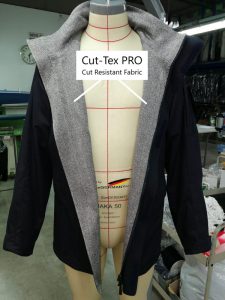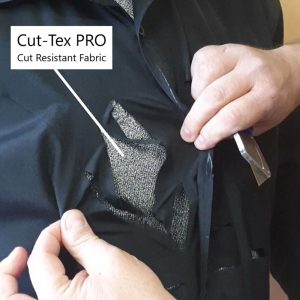It was on March 13, 2011, when my friend Craig Wylde was brutally assaulted. Having previously served as Infantry soldier in the British Army, Wylde ultimately became a prison officer at the Category A (high security) Frankland Prison, in Durham, England. One morning he opened a prisoner’s cell door, the prisoner had a broken glass bottle in his hand, he slashed Craig under his arm, he severed his artery, muscle, tendons, ligaments and also created severe nerve damage. Days later the Ministry of Justice changed the law and declared the use of glass bottles and glasses in the prison setting illegal.
This was an exceptionally tragic incident, which ultimately led to the development, design, and engineering of a high-performance cut resistant fabric known as Cut-Tex® PRO. I had already worked on some type of cut resistant fabrics, but I soon came to realize that “good performance” wasn’t good enough. So, I ended up traveling the world, meeting, and consulting some of the most respected textile engineers on the planet. Thoroughly field tested, this fabric is now allowing us and other protective clothing producers to design and produce protective clothing, reducing injuries and saving lives all over the world.
Other manufacturers of cut resistant fabrics will most likely have their own reasons for having created such type of fabric. Maybe their intentions were of similar nature, maybe they felt it was of commercial interest or it simply fit their existing product portfolio.
Homeland security and law enforcement agencies, prison services, border force, immigration, customs, counter terror units and surveillance teams have all identified a need for cut resistant fabrics and clothing, besides body armor.
We understand that muscles, tendons, ligaments and nerves of these men and women require such level of protection, preventing cut injuries and subsequent, potential rapid blood loss and shock, loss of life or simply immobility — which in certain circumstances can result in loss of life due to lack of the ability to further defend yourself.
We also must acknowledge that significant and life-altering injury can occur even when a wounded officer survives. Too soon and too often the attention wanders and the incident fades into background, while the recovering officer flounders in a morass of work comp, medical bills and looming unemployment.
“Slashing” or “slash injuries” are extremely under-reported. Historically “knife injuries” have been reported as “stab injuries,” hence we have been made to mis-believe that both mean the very same.
However, “a retrospective survey of hospital admissions data suggested that 63 percent of wounds attributable to sharp edged weapons were SLASH events,” stated Ian Horsfall and Mathew Arnold, of the Impact and Armour Group within the Department of Engineering and Applied Science at Cranfield University, Defence Academy of the United Kingdom.
Moving away from slashing, additional markets had their fair share of cut injuries, and subsequently learned to understand the incredible benefits of lightweight and comfortable cut resistant fabrics.
 Industries, such as flat/float glass and sheet metal processing, as well as air conditioning companies and recycling facilities have also reported extremely serious accidents resulting in sometimes horrendous cut injuries that needed urgent medical attention, hospital treatment and even long-term care. It is no longer good enough to purchase cut resistant gloves to protect the wearers hands. We have to learn to understand that other areas of the body are of equal or even greater risk.
Industries, such as flat/float glass and sheet metal processing, as well as air conditioning companies and recycling facilities have also reported extremely serious accidents resulting in sometimes horrendous cut injuries that needed urgent medical attention, hospital treatment and even long-term care. It is no longer good enough to purchase cut resistant gloves to protect the wearers hands. We have to learn to understand that other areas of the body are of equal or even greater risk.
Mental health care facilities, special educational needs schools, psychiatric nurses, social workers, care homes and others have also identified a need for bite resistant clothing, again made from a cut resistant fabric offering additional protective properties.
We need to stop thinking that everything will be ok. We need to stop believing that nothing is ever going to go to happen, simply based on that fact that the past has been very kind to us, and no one has been injured in our company, facility or organization yet.
The legal, financial and operational consequences for ignoring or neglecting basic health and safety regulations can be severe. The moral consequences for not looking after our workforce and dealing with the aftermath of avoidable injuries can be profound.
Cut resistant fabrics exist and they can effectively help create garments and uniforms, preventing injuries and ultimately save lives. It’s worth it.
Editor’s Note: Robert Kaiser is the CEO and Founder of England-based PPSS Group. Several great video demonstrations of him being subjected to knives, machetes, axes, shanks, other types of edged weapons, as well as blunt objects can be viewed online. Cut-Tex® PRO cut resistant fabric is produced by PPSS Group.
January 27, 2022





